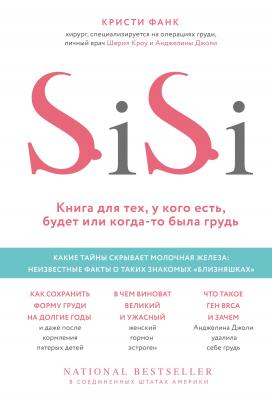SiSi. Книга для тех, у кого есть, будет или когда-то была грудь. Кристи Фанк
Читать онлайн.| Название | SiSi. Книга для тех, у кого есть, будет или когда-то была грудь |
|---|---|
| Автор произведения | Кристи Фанк |
| Жанр | Медицина |
| Серия | Красота в деталях. Научный подход к женскому здоровью |
| Издательство | Медицина |
| Год выпуска | 2018 |
| isbn | 978-5-04-099400-7 |
8
American Cancer Society, Breast Cancer Facts & Figures 2017–2018 (2017), открыто 3 декабря 2017 года, https://www.cancer.org/content/dam/cancer-org/research/cancer-facts-and-statistics/breast-cancer-facts-and-figures/breast-cancer-facts-andfigures-2017–2018.pdf.
9
American Cancer Society, Breast Cancer Facts & Figures 2017–2018 (2017), открыто 6 декабря 2017 года, https://www.cancer.org/content/dam/cancer-org/research/cancer-facts-and-statistics/breast-cancer-facts-and-figures/breast-cancer-facts-andfigures-2017–2018.pdf.
10
D. Ornish et al., “Changes in Prostate Gene Expression in Men Undergoing an Intensive Nutrition and Lifestyle Intervention,” Proceedings of the National Academy of Sciences 105, no. 24 (2008): 8369–8374.
11
K. B. Michels et al., “Coffee, Tea, and Caffeine Consumption and Breast Cancer Incidence in a Cohort of Swedish Women,” Annals of Epidemiology 12, no. 1 (January 2002): 21–26; L. J. Vatten, K. Solvoll, and E. B. Løken, “Coffee Consumption and the Risk of Breast Cancer: A Prospective Study of 14,593 Norwegian Women,” British Journal of Cancer 62 (1990): 267–270.
12
J. A. Baker et al., “Consumption of Coffee, but Not Black Tea, Is Associated with Decreased Risk of Premenopausal Breast Cancer,” Journal of Nutrition 136, no. 1 (January 2006): 166–171; J. Li et al., “Coffee Consumption Modifies Risk of Estrogen-Receptor Negative Breast Cancer,” Breast Cancer Research 13, no. 3 (2011): R49.
13
P. W. Parodi, “Dairy Product Consumption and the Risk of Breast Cancer,” Journal of the American College of Nutrition 24, no. 6 (December 2005): 556S–568S; W. Al Sarakbi, M. Salhab, and K. Mokbel, “Dairy Products and Breast Cancer Risk: A Review of the Literature,” International Journal of Fertility and Women’s Medicine 50, no. 6 (November – December 2005): 244–249; P. G. Moorman and P. D. Terry, “Consumption of Dairy Products and the Risk of Breast Cancer: A Review of the Literature,” The American Journal of Clinical Nutrition 80, no. 1 (2004): 5–14; M. H. Shin et al., “Intake of Dairy Products, Calcium, and Vitamin D and Risk of Breast Cancer,” Journal of the National Cancer Institute 94, no. 17 (September 2002): 1301–1311, 2002.
14
S. A. Missmer et al., “Meat and Dairy Food Consumption and Breast Cancer: A Pooled Analysis of Cohort Studies,” International Journal of Epidemiology 31, no. 1 (February 2002): 78–85; M. D. Holmes et al., “Meat, Fish and Egg Intake and Risk of Breast Cancer,” International Journal of Cancer 104, no. 2 (March 2003): 221–227; D. D. Alexander et al., “A Review and Meta-analysis of Red and Processed Meat Consumption and Breast Cancer,” Nutrition Research Reviews 23, no. 2 (2010): 349–365.
15
V. Estrella et al., “Acidity Generated by the Tumor Microenvironment Drives Local Invasion,” Cancer Research 73, no. 5 (2013): 1524–1535; J. B. McGillen et al., “A General Reaction – Diffusion Model of Acidity in Cancer Invasion,” Journal of Mathematical Biology 68, no. 5 (2014): 1199–1224; K. O. Alfarouk, A. K. Muddathir, and M. E. A. Shayoub, “Tumor Acidity as Evolutionary Spite,” Cancers 3, no. 1 (2011): 408–414; M. F. McCarty and J. Whitaker, “Manipulating Tumor Acidification as a Cancer Treatment Strategy,” Alternative Medicine Review 15, no. 3 (2010): 264–272.
16
C. R. Cassileth, Principles and Practice of Gastrointestinal Oncology (Philadelphia: Lippincott Williams & Wilkins, 2008): 137.
17
S. R. Harris et al., “Clinical Practice Guidelines for the Care and Treatment of Breast Cancer: 11. Lymphedema,” Canadian Medical Association Journal 164, no. 2 (2001): 191–199.
18
L. Chen, K. E. Malone, and C. I. Li, “Bra Wearing Not Associated with Breast Cancer Risk: A Population-Based Case-Control Study,” Cancer Epidemiology, Biomarkers & Prevention 23, no. 10 (2014): 2181–2185.
19
D. K. Mirick, S. Davis, and D. B. Thomas, “Antiperspirant Use and the Risk of Breast Cancer,” Journal of the National Cancer Institute 94 (2002): 1578–1580; P. D. Gikas, L. Mansfield, and K. Mokbel, “Do Underarm Cosmetics Cause Breast Cancer?” International Journal of Fertility and Women’s Medicine 49 (2004): 212–214.
20
P. D. Darbre, “Aluminum, Antiperspirants and Breast Cancer,” Journal of Inorganic Biochemistry 99, no. 9 (2005): 1912–1919.
21
P. D. Darbre, F. Mannello, and C. Exley, “Aluminium and Breast Cancer: Sources of Exposure, Tissue Measurements and Mechanisms of Toxicological Actions on Breast Biology,” Journal of Inorganic Biochemistry 128 (2013): 257–261.
22
C. C. Willhite et al., “Systematic Review of Potential Health Risks Posed by Pharmaceutical, Occupational and Consumer Exposures to Metallic and Nanoscale Aluminum, Aluminum Oxides, Aluminum Hydroxide and Its Soluble Salts,” Critical Reviews in Toxicology 44, no. 4 (2014): 1–80.
23
P. D. Darbre et al., “Concentrations of Parabens in Human Breast Tumours,” Journal of Applied Toxicology 24 (2004): 5–13.
24
L. Barr et al., “Measurement of Paraben Concentrations in Human Breast Tissue at Serial Locations across The Breast from Axilla to Sternum,” Journal of Applied Toxicology 32 (2012): 219–232.
25
D. K. Mirick, S. Davis, and D. B. Thomas, “Antiperspirant Use and the Risk of Breast Cancer,” Journal of the National Cancer Institute 94 (2002): 1578–1580.
26
S. Fakri, A. Al-Azzawi, and N. Al-Tawil, “Antiperspirant Use as a Risk Factor for Breast Cancer in Iraq,” Eastern Mediterranean Health Journal 12, nos. 3–4 (2006): 478–482.
27
K. G. McGrath, “An Earlier Age of Breast Cancer Diagnosis Related to More Frequent Use of Antiperspirants/Deodorants and Underarm Shaving,” European Journal of Cancer Prevention 12 (2003): 479–485.
28
World Cancer Research Fund International, “Breast Cancer Statistics,” открыто 10 июня 2017 года, http://www.wcrf.org/int/cancer-facts-figures/data-specific-cancers/breast-cancer-statistics.
29
M. Donovan et al., “Personal Care Products that Contain Estrogens or Xenoestrogens May Increase Breast Cancer Risk,” Medical Hypotheses 68 (2007): 756–766.
30
L. Rosenberg et al., “Hair Relaxers Not Associated with Breast Cancer Risk: Evidence from the Black Women’s Health Study,” Cancer Epidemiology and Prevention Biomarkers 16, no. 5 (2007): 1035–1037.
31
M.
